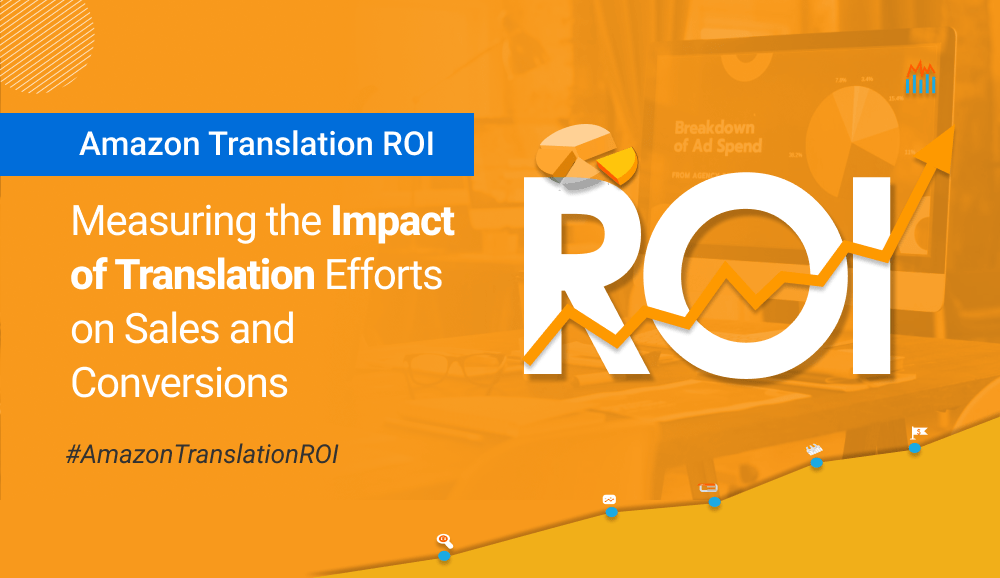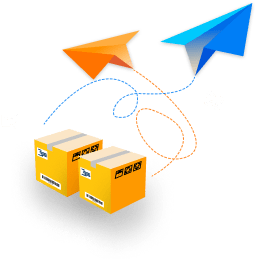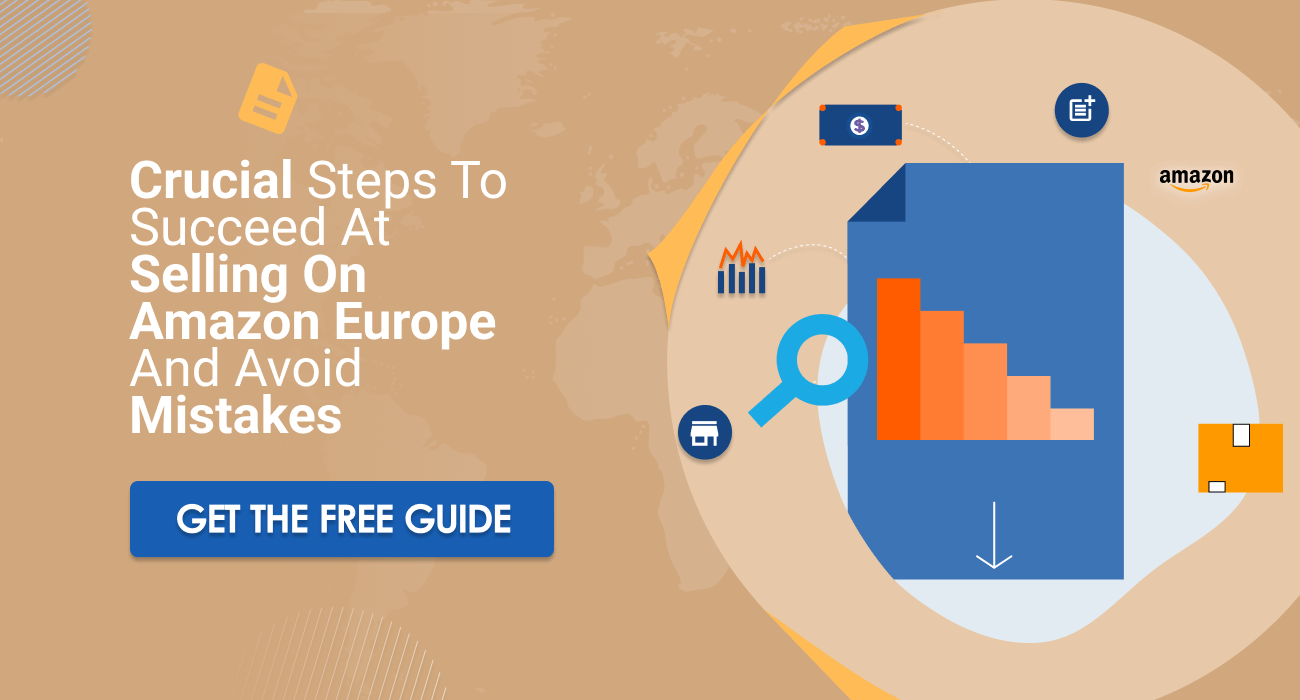Amazon Translation ROI: Measuring the Impact of Translation Efforts on Sales and Conversions

Content Strategist at MarginBusiness

Table of Contents
If you want to venture your e-commerce business in the global marketplace, translation plays a vital role in breaking down language barriers and enabling businesses to connect with diverse audiences.
To thrive in this interconnected world, it’s essential to effectively communicate with customers from different cultures and regions.
Amazon, as a global e-commerce giant, understands this necessity better than anyone else.
In this blog post, we’ll look into the realm of Amazon Translation ROI and explore how to measure the impact of translation efforts on sales and conversions.
We’ll explore key metrics for measuring translation ROI, reveal effective tools and techniques for measurement, showcase real-world case studies, and provide actionable strategies for optimizing your translation ROI on Amazon.
“By localizing your content and product listings, you can enhance the user experience, build trust, and establish credibility with your target audiences.

Significance of Measuring Amazon Translation ROI
Measuring the ROI of your Amazon translation efforts is not just a mere formality; it holds significant importance in the success of your business.
A study by CSA Research found that localized content can increase website conversions by a staggering 70%?
Imagine the potential growth your business can achieve by accurately measuring the ROI of your translation endeavors. It allows you to allocate resources effectively, focus on high-performing markets, and identify areas for improvement.
By measuring the ROI of your translation efforts, you gain valuable insights into how localized content impacts your Amazon sales. For instance, a study conducted by the European Commission revealed that 90% of European online shoppers prefer to buy products in their native language.
By understanding the ROI of translation, you can tailor your product listings, optimize keywords, and enhance your overall Amazon marketing strategy to maximize conversions and revenue.
So, if you haven’t been prioritizing translation ROI measurement, it’s time to start and receive the benefits.
Expert Tip:
To accurately measure Amazon translation ROI, consider implementing unique tracking codes or utilizing Amazon’s built-in analytics tools. This way, you can directly attribute sales and conversions to specific translations and assess their effectiveness in driving customer engagement and revenue.
Remember,
Language nuances and cultural preferences can vary greatly, so testing and iterating are key to unlocking translation success on Amazon.
How Amazon Translation Drives Sales and Conversions
Expanding your business beyond borders and tapping into international markets can be a game-changer for your Amazon sales.
However,
To succeed in these markets, you need to bridge the language gap and effectively communicate with your target audience. This is where Amazon Translation comes in, empowering you to reach customers in their native language and drive sales and conversions like never before.
In this section, we’ll explore how Amazon Translation can propel your business forward by expanding customer reach, enhancing user experience, and building trust and credibility.
🚀 Expand Customer Reach in International Markets
When you venture into international markets, language barriers can become a significant roadblock to connecting with potential customers.
By leveraging Amazon Translation, you can break down these barriers and expand your customer reach exponentially.
Did you know that over 70% of internet users are non-English speakers? The huge untapped potential waiting for you in markets where customers prefer to shop in their native language.
With properly localized content, translated product listings, and accurate keyword optimization, you can unlock new opportunities and capture the attention of a global audience.
🚀 Enhance User Experience through Localized Content
User experience is a crucial factor in driving conversions on Amazon.
When customers can navigate your product listings, understand your offerings, and engage with your brand seamlessly, they are more likely to make a purchase.
Amazon Translation allows you to enhance user experience by providing localized content that resonates with your target audience.
For instance,
A study by Common Sense Advisory found that 72.4% of consumers are more likely to buy a product when the information is available in their own language.
🚀 Building Trust and Credibility
Trust and credibility are essential for your e-commerce business success. When customers see that you have taken the effort to translate your content into their language, it signals your commitment to their needs and fosters trust.
Localized content makes customers feel understood, increasing their confidence in your brand and products. Additionally, translating customer reviews and ratings allows potential buyers to see the positive experiences of others in their own language, further building trust and credibility.
By investing in Amazon Translation, you can establish yourself as a reliable and trustworthy seller, ultimately driving more sales and conversions.
Expert Tips:
- Conduct thorough market research to identify high-potential international markets for expansion. Prioritize languages that have a significant user base and align with your target audience.
- Localize not just the product listings but also other elements such as customer support, packaging, and marketing materials. Consistency in language and branding across all touch-points helps build a strong and cohesive customer experience.
Key Metrics for Measuring Translation ROI
Measuring the return on investment (ROI) of your translation efforts on Amazon is crucial for understanding the impact on your sales and conversions. By tracking the right metrics, you can gain valuable insights into the effectiveness of your translated listings and make data-driven decisions to optimize your strategy.
In this section, we’ll explore the key metrics you should focus on to measure translation ROI on Amazon, including sales revenue from translated listings, conversion rate of localized content, and customer feedback and ratings.
🚀 Sales Revenue from Translated Listings
One of the primary metrics to consider is the impact on your sales revenue.
By analyzing the sales performance of your translated listings compared to non-translated ones, you can determine the financial impact of your translation efforts.
For example,
Let’s say you have a product listing in English and decide to translate it into Spanish. By monitoring the sales generated from the Spanish version, you can quantify the additional revenue attributed to the translation.
Keep a close eye on the sales growth and identify any patterns or trends that emerge from specific language versions, help you prioritize and invest in the most profitable translations.
🚀 Conversion Rate of Localized Content
Another critical metric for measuring translation ROI is the conversion rate of your localized content.
It’s not just about reaching more customers; it’s about persuading them to take action and make a purchase. By analyzing the conversion rates of your translated listings, you can assess the effectiveness of your language and messaging in driving customer engagement.
For instance,
let’s say you translate your product descriptions and optimize keywords for a specific language. By comparing the conversion rates of the translated version with the original, you can determine if the localization is resonating with the target audience and driving higher conversions. Use this data to refine your translation strategy and continuously improve your conversion rates.
🚀 Customer Feedback and Ratings
Customer feedback and ratings provide valuable insights into the impact of your translations on customer satisfaction and perception of your brand.
Monitor customer reviews, ratings, and feedback specific to language versions to gauge the effectiveness of your translations. Positive feedback and high ratings indicate that your localized content is resonating with customers, building trust, and positively impacting their purchase decisions.
On the other hand, negative feedback or low ratings may signal areas for improvement in your translation efforts.
Expert Tip:
Leverage Amazon’s automated translation quality metrics, such as the “Translation Quality Evaluation” (TQE) score, to assess the quality of your translations. It includes fluency, grammar, and localization to provide an objective evaluation. Aim for higher TQE scores and continually improve your translations based on the feedback.
Tools and Techniques for Effective Translation ROI Measurement
To accurately assess the impact of translation on sales and conversions, you need effective tools and techniques.
In this section, we’ll explore a range of practical tools and techniques that can help you measure translation ROI effectively on Amazon
🚀 Utilizing Amazon’s Data Analytics and Reporting Features
When it comes to measuring translation ROI on Amazon, you have a powerful ally at your disposal – Amazon’s data analytics and reporting features.
Dive into your Seller Central dashboard to access valuable insights and metrics related to your translated listings. Monitor sales performance, conversion rates, and customer engagement data specific to different language versions. Identify trends, patterns, and areas for improvement by leveraging the wealth of data provided by Amazon’s analytics tools.
By understanding how different translations impact your key performance indicators, you can make informed decisions to optimize your translation strategy and drive better results.
🚀 Implementing A/B Testing for Language Variations
A/B testing is a powerful technique that can help you assess the effectiveness of different language variations and optimize your translation ROI.
With A/B testing, you can create multiple versions of your product listings, each with a different translation, and track their performance.
For example,
You can test two different translations for a specific market and compare their conversion rates. By analyzing the data and identifying the translation that generates higher conversions, you can make data-driven decisions to refine your translations and maximize ROI.
A/B testing allows you to experiment, iterate, and continuously improve your language variations, ensuring you’re delivering the most effective content to your target audience.
🚀 Tracking Customer Behavior and Engagement Metrics
Understanding how customers interact with your translated listings is key to measuring translation ROI.
Monitor metrics such as click-through rates, time spent on product pages, and add-to-cart rates specific to different language versions.
For example,
If you notice a high bounce rate on a translated listing, it may indicate that the language or messaging is not resonating with your target audience.
Use these insights to make data-informed adjustments and optimize your translations for better customer engagement and increased conversions.
Expert Tip:
Consider integrating a customer feedback mechanism on your translated product listings. Encourage customers to provide feedback or reviews in their native language to gain valuable insights into their experience with the translations.
Strategies for Optimizing Translation ROI on Amazon
To maximize the return on investment (ROI) of your translation efforts on Amazon, it’s crucial to employ effective strategies that align with your target markets and customer preferences.
In this section, we’ll explore practical strategies that can help you optimize translation ROI and drive better results on Amazon and provide you with actionable tips to boost your translation ROI on Amazon.
🚀 Conduct Thorough Market Research and Linguistic Analysis
Before diving into translation, it’s essential to conduct thorough market research and linguistic analysis.
Gain a deep understanding of your target markets, their preferences, and cultural nuances. Identify the languages that have a significant user base and align with your ideal customers.
By investing time and effort in comprehensive research and analysis, you can ensure that your translation efforts are tailored to the needs of your target markets, leading to higher engagement and conversions.
🚀 Focus Translation Efforts on Specific Target Markets
Rather than adopting a one-size-fits-all approach, it’s more effective to focus your translation efforts on specific target markets.
By narrowing down your translations to key markets, you can allocate your resources more efficiently and create a more personalized and impactful customer experience.
For instance,
If you’re targeting the German market, consider translating your product listings, optimizing keywords, and adapting your marketing strategy specifically for German-speaking customers.
🚀 Monitor and Adapt Various Translation Strategies
Translation is not a one-time task; it requires ongoing monitoring and adaptation. Continuously track the performance of your translations, analyze the data, and make data-driven adjustments to optimize your strategy.
Experiment with different translation variations, messaging, and content presentation to see what resonates best with your target audience.
Embrace a growth mindset and be open to iterating and refining your translation strategy based on the feedback and data you receive.
Expert Tip:
Consider leveraging machine translation combined with human review for cost-effective and accurate translations. While machine translation can provide a quick initial translation, having a human linguist review and fine-tune the output ensures linguistic accuracy and cultural appropriateness.
Key Takeaways:
1. Measurement Matters:
Measuring the impact of translation efforts on sales and conversions is crucial for understanding the ROI and optimizing your global marketing strategy on Amazon.
Utilize key metrics such as sales revenue from translated listings, conversion rates of localized content, and customer feedback and ratings to gain insights into the effectiveness of your translations.
2. Tools and Techniques:
Leverage tools and techniques such as Amazon’s data analytics and reporting features, A/B testing for language variations, and tracking customer behavior and engagement metrics.
3. Strategic Approaches:
Adopt strategic approaches to optimize translation ROI. Focus your translation efforts on key markets to allocate resources effectively and create personalized customer experiences. Continuously monitor and adapt your translation strategies based on feedback and data to drive better results.
Invest in Translation for Global Business Success!
Expanding your business globally requires breaking language barriers and effectively communicating with customers in their native languages. By investing in translation, you can unlock new opportunities, reach a wider audience, and drive sales and conversions like never before.
Don’t miss out on the immense potential of international markets. Let’s translate your Amazon product listings, optimize content, and deliver personalized experiences to customers worldwide.

Z.D. Babar
Connect @ LinkedIn
 Co-Founder at Qontentify – HEO Content Optimization Platform
Co-Founder at Qontentify – HEO Content Optimization Platform  Copywriter, SEO + HEO Expert and Content Strategist at B2B Platforms
Copywriter, SEO + HEO Expert and Content Strategist at B2B Platforms Subscribe & Scale!
Free Join 10827 Successful Amazon Sellers Who Already Have a Head Start
⚡️ Let’s Supercharge Your Amazon Business 📦








